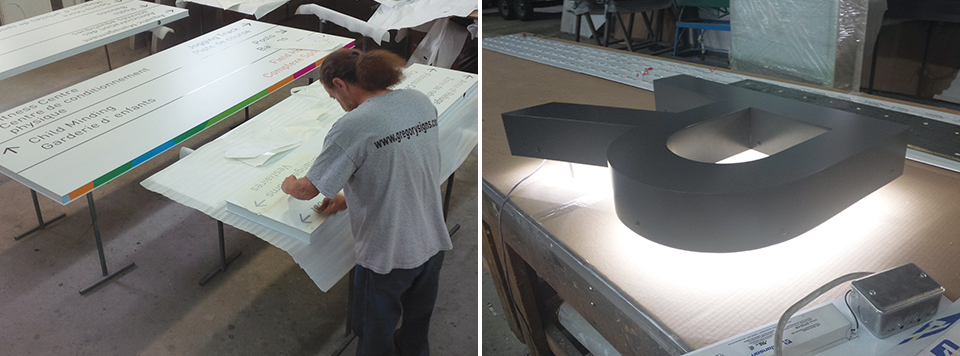As the project progressed, Entro specified three primary sign materials—opaque vinyl, aluminum and acrylic—and defined the facility’s typography style before designing building identification (ID), entrance, traffic, directory, electronic message centre (EMC), directional, emergency, departmental and room signage, among other elements within the system. The team consulted with the university and the city, which provided guidelines for signs
and graphics.
“It’s not just another U of T campus signage program,” says Schliemann, “but while our designs were somewhat inspired by and will complement the Pan Am Games, they were not Pan Am-centric. There’s more of a sense that the Pan Am branding will surround the building during the games.”
So, as Entro was not beholden to Pan Am brand standards, the designers were able to create a bold new look for the TPASC sign system. One of their points of inspiration was the building’s design by NORR’s David Clusiau, which featured ‘offset’ walls and façades.
“We were inspired by these forms in the architecture that resembled shifting ice, which led to our use of offset planes in our pylon designs,” says Schliemann. “The building and the sign system are synchronized visually. There’s also a water theme in our supergraphics, which feature abstracted blue patterns along the main corridor to the pool and changing area, as well was providing a backdrop for the diving boards, which will get a lot of airplay on TV. The graphics in the field house, by comparison, are more colourful, with red and orange tones.”
More than 1,000 signs
Gregory Signs & Engraving in Vaughan, Ont., was commissioned to create and install the signs. The contract was awarded in November 2013 and work
continued through the opening of the facility the following September, but the company’s preparation process began much earlier.
“Infrastructure Ontario sought concepts for the various facilities that would be needed for the 2015 Pan Am Games many years in advance,” explains David Grose, sales manager for Gregory Signs. “We got involved at that point with various groups submitting design-build tenders, where we suggested an appropriate budget for and amount of signage at each site. One of those groups was PCL Construction, which ended up submitting the winning bid for TPASC.”
So, after PCL worked with Entro and the architect to determine the right mix of signs for the facility, Gregory Signs was brought back on board.
“Our job was to turn conceptual designs into buildable signs,” says Grose. “We added support structures for hanging signs, verified French translations could be accommodated under English type and arranged fibre optic connectivity to the outdoor light-emitting diode (LED) screens.”
The company also had to pour concrete footings for pylon signs before the site was even landscaped, using ‘control points’ to determine the right locations and estimating intended pylon heights because the final grading of the earth was not yet finished.
“We had to stake them all out and make sure they were level,” says Grose.






